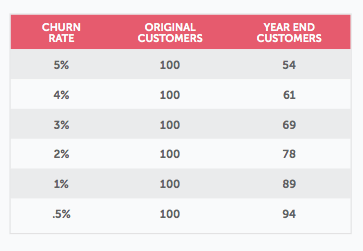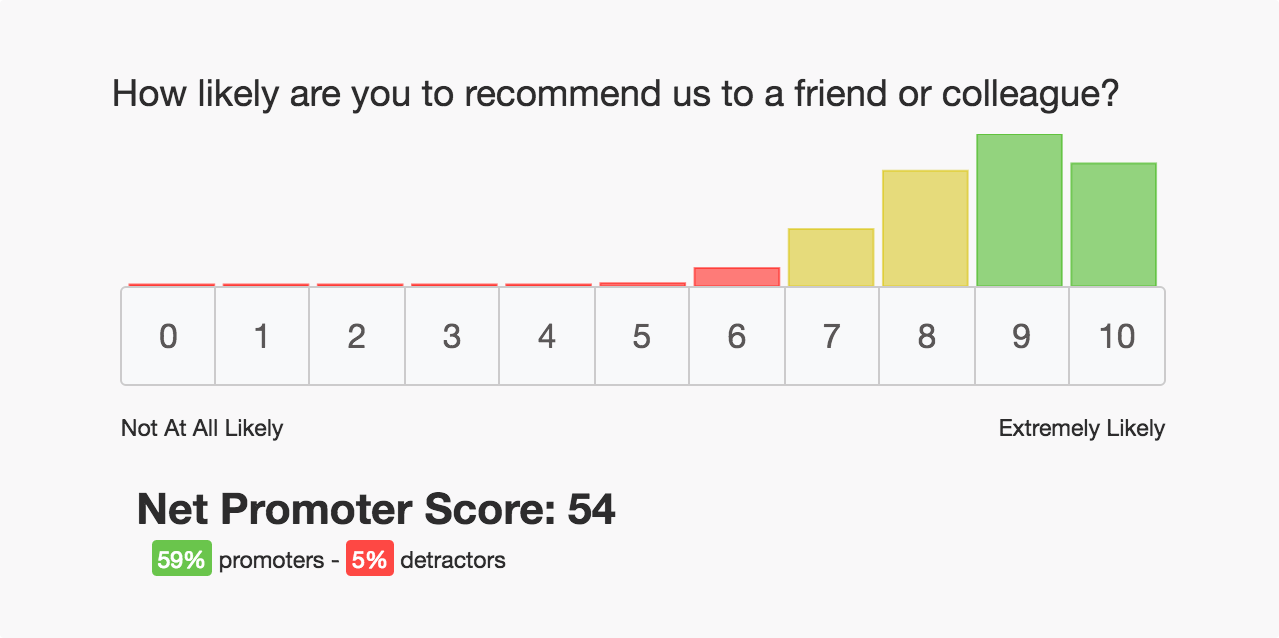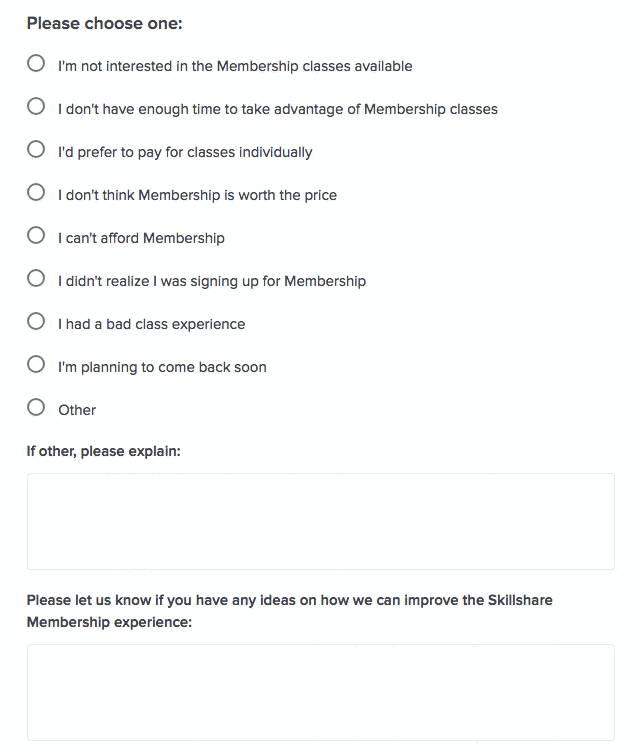
Strategies for reducing churn
Strategies for reducing churn
Learn about how to reduce churn, keep customers and clients with you longer, and build valuable long-term relationships.
Introduction
Why care about churn?
By 2013, Alex Turnbull’s software startup, Groove, had started to grow. As he glanced at his company’s early metrics, a monthly churn rate of 4.5% (the percentage of customers who canceled each month) seemed relatively modest.
But some quick back-of-the-envelope math revealed a different story: if customers continued to churn at that rate, Groove would lose almost half of its customer base each year. It was an all-too-common obstacle.
For startups like Groove, and even for Fortune 500 companies, the effects of customer churn can be devastating. “Churn is the silent killer of your company,” says Patrick Campbell, CEO of Profitwell. “If you don’t tackle churn early, you’ll be working extremely hard just to stand still.”
In this guide, we’ll analyze the causes of churn and share real-world tactics that entrepreneurs like Alex Turnbull have used to combat churn and turn customer retention into one of their business’s most important growth strategies.

What is Churn?
It’s a critical measure for both transactional and subscription businesses because it’s typically more difficult (and expensive) to acquire a new customer than to keep an existing one.
In a transactional business, churn occurs when customers don’t make repeat or additional purchases in a set period of time. Unless a company is selling big ticket, one-off purchases—for example, a home—most transactional businesses rely on customers becoming familiar with their brand and then buying additional products or services from them.
For subscription businesses, churn can be an even more critical measure because oftentimes their customer acquisition costs (CAC) are higher than the initial price of their products. Take, for example, a company with a $500 CAC that sells a $100 per month subscription service. If customers aren’t retained for a minimum of five months, the company fails to break even on the sale and is actually losing money.
Research shows that 70-95% of subscription revenue is typically generated after the initial sale via renewals and upsells. In other words, the churn is where the money is.
How Groove righted its ship
Alex began fighting Groove’s churn problem by researching user habits and trying to identify behaviors that correlated to customers churning within the first 30 days of signing up. He quickly stumbled across two revealing statistics.
First, users who stuck around engaged with his product for an average of 3 minutes and 18 seconds when they first signed in. Customers that churned, by comparison, only lasted 35 seconds during this initial session. Second, committed customers logged into Groove 4.4 times per day compared to just 0.3 logins per day for churned customers.
Alex and his team realized these metrics represented leading indicators of churn, internally dubbing them “Red Flag Metrics” or RFMs. They began tagging CRM records for accounts that showed RFM behaviors and quickly got to work automating emails to any user whose initial session with the product lasted less than two minutes or who logged into the product less than twice within 10 days of signing up.
The emails contained educational videos that trained new customers on how to use Groove successfully, with content focused on getting users to configure their accounts, adopt new features, and quickly realize value from the product. The timely interventions worked—Groove’s red flag metrics and subsequent campaigns helped the company reduce churn by 71%. The churn rate that had once threatened to halt his startup’s growth potential had finally begun to drop.
How to calculate churn
To calculate churn, use this formula:
Churn = # of customers lost in a given period / # of customers you started the period with
For example, if a company started the month of June with 500 customers and lost 25 customers throughout the course of the month, the company’s churn rate for the month is 25 / 500 = .05 or 5%.
You can also calculate revenue churn (the percentage of your total revenue lost over a given time period) this way. For example, if the same business generated $500,000 of revenue in June and failed to retain $40,000 in revenue, then the company’s revenue churn rate is $40,000 / $500,000 = .08 or 8%.
When calculating churn for a subscription business, only include subscriptions that have actually expired. Because a customer can change their mind after clicking Cancel, you should wait until that subscription or revenue is no longer active (which is usually at the end of the month) because you still have an opportunity to save these accounts.
Whether you choose to track customer churn or revenue churn, consistency is key—you’ll want to see relative performance month-over-month and year-over-year so you can monitor whether you’re effectively reducing churn or have a growing problem. Regardless of what your churn rate currently is, you should always strive to decrease it.
Why understanding churn is important
While it's clear that losing customers is bad for business, the importance of churn is often underestimated; it’s a problem that only escalates as a company grows. “As a company becomes larger, the size of the subscription base becomes large enough that any kind of churn against that base becomes a large number,” says venture capitalist David Skok. “That loss of revenue requires more and more bookings coming from new customers just to replace the churn.”
While a 5% churn rate may sound modest, the table below shows how, over the course of a year, it results in your company losing almost half its customer base—exactly the problem faced by Alex Turnbull’s team at Groove.
Improvements in customer retention may not come with the glamor or attention that making new sales does, but the revenue implications of even small improvements can be massive. According to a study by Bain & Company, a 5% increase in customer retention can increase revenue 25-95%. It’s no wonder that churn is a metric increasingly used by investors to measure the overall health of subscription businesses.
While churn can very quickly poison a subscription business’s growth potential, its impact on revenue for transactional businesses is also significant. According to KPMG, customer retention is the single biggest driver of revenue for retail companies—even greater than customer acquisition.
Next we’ll explore some of the most common causes of churn.
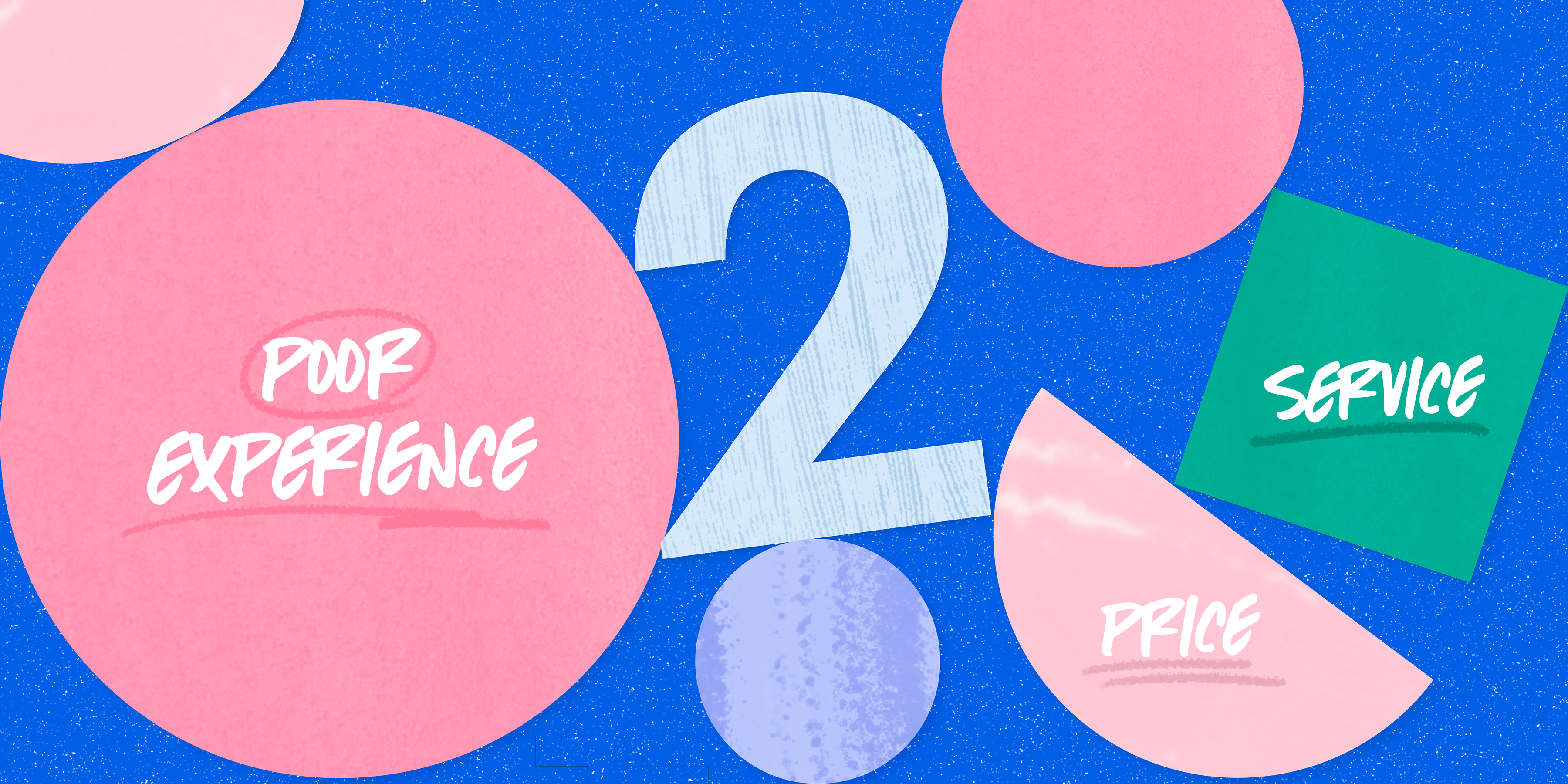
Common Causes of Churn
Selling to the wrong customers
It’s often wrongly assumed that churn is the result of some sort of deficiency with your product or service. But your sales and marketing teams can be inadvertently causing churn. Ultimately, selling to the wrong customer is “the consumer equivalent of bad relationships—they’ll try to change you, complain about you, and never really love you,” says Nicole Elizabeth Demere, a B2B Customer Success consultant.
This problem can typically be rectified by a shift in mindset; rather than focusing on selling at every opportunity possible, your sales team needs to focus on selling to your ideal customer profile. Here are some leading indicators that you might be selling to the wrong customer:
- The customer never realized the full value of your product
- The customer struggles to use your product or service effectively
- The customer has customer service or feature requests that few others do
- You didn’t build your product or service with this customer type in mind
- The customer has expectations that you clearly won’t be able to deliver on
Poor user experience
If your product is difficult to use or buggy, or it doesn’t help your customer achieve their objective, you will likely see a high churn rate. A poor user experience can be particularly debilitating when a prospect is first engaging with your product or service.
If the first impression is frustrating for the user, they’re likely to move on quickly and may not give your product a second chance. This is particularly disappointing when your product does deliver what the customer is looking for but the user experience prevents them from realizing that value.
Poor customer service
If you’ve ever been to a DMV or been put on hold when calling in for customer support, you know how frustrating poor customer service can be. Frustration often increases further when customer service reps aren’t knowledgeable or empowered enough to solve your problem.
According to a study by Zendesk, 66% of B2B buyers and 52% of B2C buyers have stopped buying from a brand after a bad customer service interaction. If you don’t provide great customer service to your clients, one of your competitors almost surely will.
Pricing
The price of your products or services can also create churn, especially when the price of your product doesn’t align with the value your product is delivering.
This frequently happens when customers don’t understand all the benefits of the product. They may only be using a few of your product's or service's features, which means they aren’t realizing the full value of what you’re offering.
Small businesses are particularly at risk to churn based on price, as they are more likely to go out of business and tend to be more price-sensitive than larger companies.
A key user/advocate/sponsor leaves your customer’s company
If you sell your product or service to other companies (B2B), churn often occurs if a key contact at one of your customers changes jobs or leaves the company altogether. This happens most frequently when the departing person is someone who initially championed the use of your product or service—they may have been the person that originally made the decision to buy your product, or the person who is the most active user of your product or service.
A key departure like this could be a leading indicator of churn—you should reach out to your customers and play a more active role in helping them through the transition. It can provide a valuable opportunity to reach out to the departing person as well; as someone who is already familiar with your product, you may be able to sell to them again once they get settled in their new role at a different company.
Next we’ll look at some tools you can use to identify which of these causes of churn is plaguing your business.
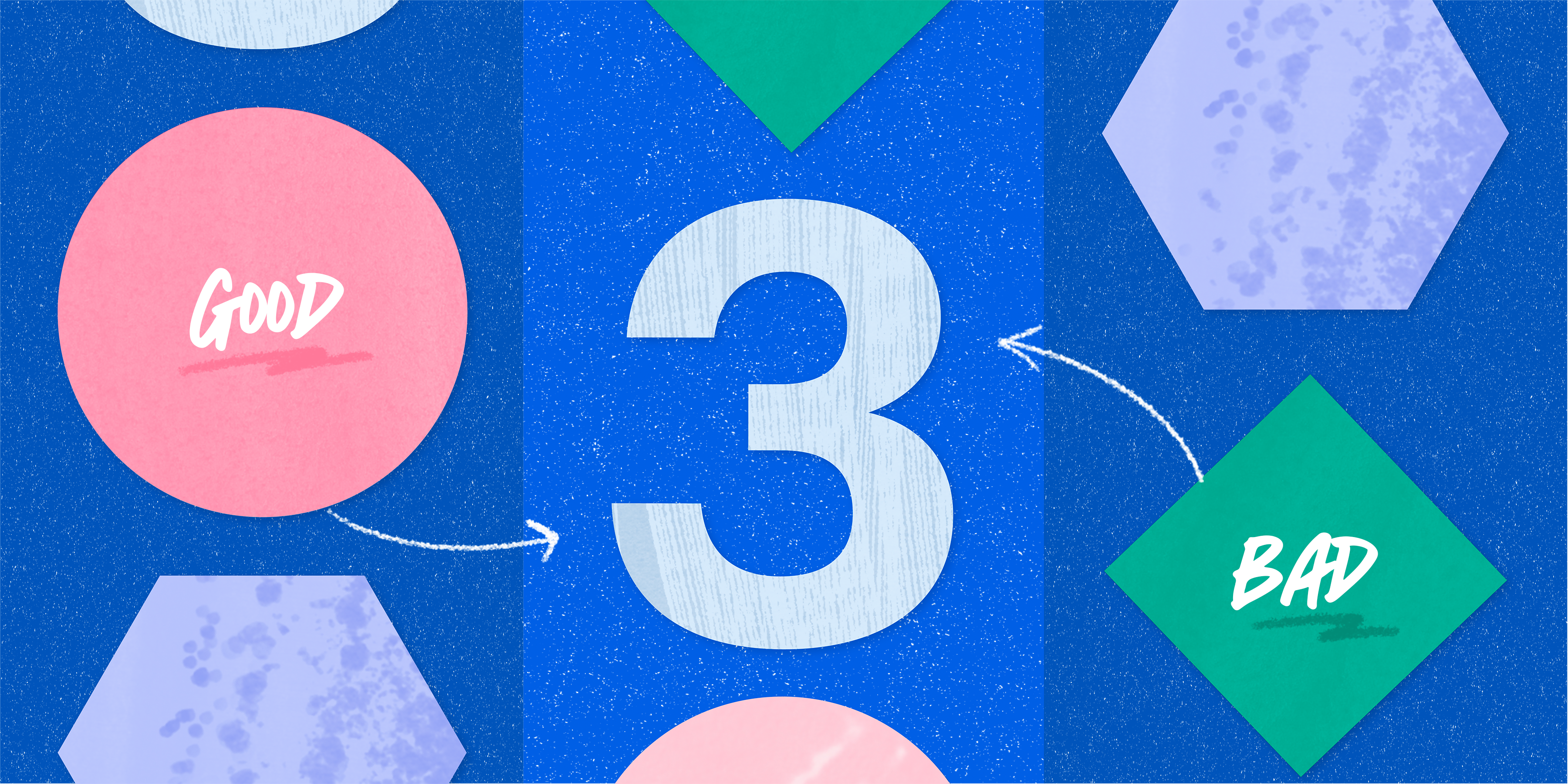
Understanding When and Why Customers Churn
There’s no one-size-fits-all approach to fighting churn. Before you start wielding your churn-fighting sword, you need to systemize a process for capturing data on when and why customers are churning.
Two commonly used tools to understand why customers churn are net promoter score (NPS) and cancellation surveys. NPS surveys periodically poll a subsegment of your customer base, asking them a single question: “How likely are you to recommend us to a friend or colleague?”
Respondents select a value of 1 (not at all likely) to 10 (extremely likely); scores of 9 or 10 are designated as “promoters” of your product, scores of 7 or 8 are passive, and scores of 1-6 are “detractors.”
The percentage of total survey respondents that are “promoters” minus the percentage of respondents that are “detractors” represents your NPS score, which is one of the most commonly used methods of measuring customer satisfaction. Your NPS score will range from -100 (all detractors) to +100 (all promoters)—a score above 0 is generally considered decent.
Retently provides some useful benchmarking data on NPS scores across various industries:
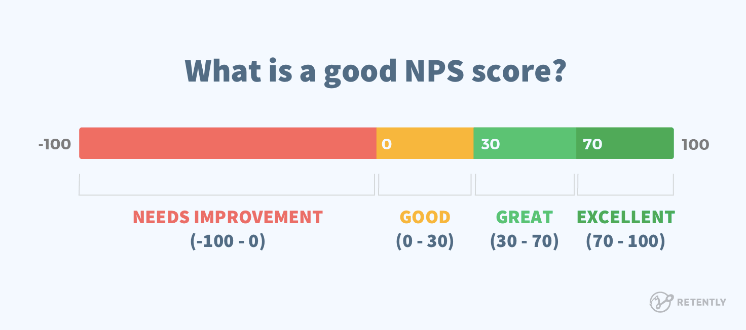
There are a few benefits to using NPS to understand why customers churn.
- It’s easy to implement.
- It can surface accounts that aren’t happy with your product or service, so you can proactively reach out to save them before they churn.
- In addition to selecting a value of 1-10, many companies offer an open-ended dialog box allowing customers to provide additional context or comments on why they selected the score that they did. This qualitative data is rich with insights into why customers are or aren’t happy with your product or service.
Cancellation surveys are the most commonly used strategy to understand why customers churn because they collect data from customers at the point when they are actually canceling.
The design of the survey can have a significant impact on both the number of submissions and the usefulness of the data. Asking closed questions (think multiple choice or checklist) can be helpful in quantifying the common reasons why customers churn.
That said, if there aren’t significant differences in the answers, you might benefit more from asking open-ended, qualitative questions:
Alex's team at Groove got eight times more responses (10.2%) when they changed to an open-ended cancellation survey question. They were able to almost double this response rate once again when they made a small change to the language used in their survey. Rather than asking, “Why did you cancel?” the company began asking, “What made you cancel?”
This change resulted in their response rate increasing to 19%, which they credit to what made you cancel? sounding less accusatory than why did you cancel? It’s worth iterating on your approach to increase your response rate and capture as many useful answers as possible:

Most companies will want to employ both a cancellation survey and some other means of measuring customer satisfaction (like NPS). This is important because you want to not only understand why customers are canceling, but also identify customers who are experiencing problems so you can intervene before cancellations occur.
Once you’ve implemented a process to understand why customers churn, you should carefully analyze the data to look at the timing of when churn occurs relative to when customers purchased your product or service. The timing of churn is a great indicator of why customers churned in the first place, as well as what you’ll need to do to combat churn moving forward.
Short-term churn
For subscription businesses, most churn will happen in the first few months of using your product or service. This makes sense—customers are trying it out to see if they get value from it. If they aren’t, you may be selling to the wrong customers, or the onboarding process for your product or service might be unclear.
To combat this, you should look at the attributes of your customers that are most successful with your product and focus on helping new customers reach an “aha” moment that demonstrates value as quickly as possible.
Medium-term churn
Reducing medium-term churn comes down to improving the overall quality and value your product or service delivers.
Medium-term churn tends to occur within 3-12 months of using your product or service; at this point customers have decided that the value they’re getting from your product isn't enough.
Long-term churn
Long-term churn relates to customers who have already used your product or service for a significant period of time—often over 12 months. Long-term churn often occurs if your product is no longer relevant or if better (or cheaper) alternatives have entered the market.
To decrease long-term churn, focus on getting users to upgrade their subscriptions or buy additional products and services from your company. When you see customers expanding their use of your products and services, it’s a solid indication that they’re realizing value and that your products are becoming more deeply ingrained in their business processes or daily lives.
Next we’ll look at the churn-busting strategies you can employ to improve customer and revenue retention.
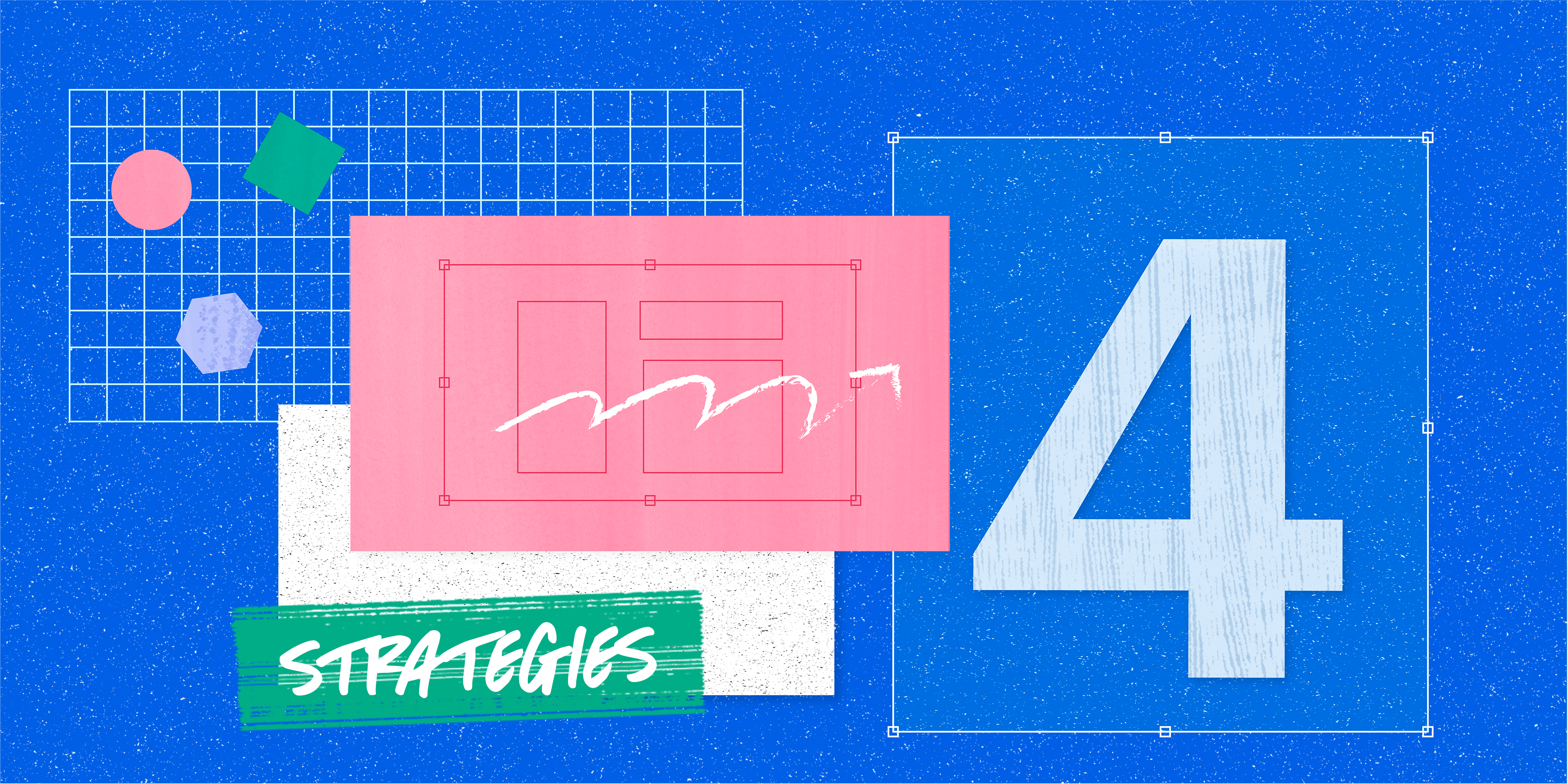
Strategies to Reduce Churn
Sell to the right customer
If your sales team is consistently selling deals that churn relatively quickly, they may be overpromising during the sales process. Alternatively, your marketing team might be targeting the wrong type of buyer persona with their lead generation programs.
Solving this issue always begins with top-down education; your sales and marketing teams need to understand the devastating effects that churn can have on growth. But education alone is typically not enough to change the behavior of sales reps who rely on closing deals to hit their quota; you may need to realign your incentive structure to reward sales reps who sell to customers who stick around.
Improve new customer onboarding
When customers first use your product or service, they typically start with some sort of onboarding process that familiarizes them with your offering. Don’t underestimate the value of this first impression, as most churn occurs early on.
Creating a great onboarding process begins with mapping out an introductory blueprint that you want all customers to experience. What aspects of your product do you want to expose them to? What education do they need? What do you want them to achieve early on?
As you design this process, focus on getting customers to an “aha” moment—one where they realize their personal benefit of your product or service—as quickly as possible.
It can also be helpful to provide an onboarding guide or even progress bars that show new customers how far along they are in your onboarding process and what tasks are still required or recommended.
Useronboard.com breaks down the onboarding sequences of many online companies and is a great resource for onboarding inspiration.

Example of how UserOnboard breaks down Buffer's onboarding experience.
Track product engagement
By measuring how your product is actually being used, you can recognize at-risk customers that are more likely to churn; if a customer isn’t using your product, why would they continue to pay for it?
To track product engagement, first identify what actions customers take that represent “valuable use” of your product. For example, an online product like Mailchimp might track how often users are logging in to the product and how often they send email campaigns. For a transactional business like a restaurant, product engagement could simply be a measure of how often customers come in for a meal.
But never make assumptions without data to back it up.
Customer messaging platform Intercom believed that “activity churn” (when customers stopped engaging with their product) was a leading indicator of overall customer churn.
But through careful analysis of product engagement data, the company recognized that it was common for individual users to stop engaging with the product for periods of time (like when a customer went on a summer vacation), and that lack of engagement wasn’t a leading indicator of churn.
Intercom used this knowledge to trigger email campaigns designed to increase product usage only when they saw a significant drop-off in login activity for entire teams or companies, which was a leading indicator of churn.
This insight helped the company avoid delivering a bad user experience for individual users who’d likely have returned from their vacations to unnecessary emails.
Increase communication
Whether it’s additional emails, phone calls, or direct mailers, increased communication with customers is one of the most commonly employed tactics to reduce churn. At the very least, this outreach provides a friendly reminder that keeps your product or service top of mind.
For example, social media management tool Buffer fights churn proactively by sending customers emails telling them that their social queue is running low and they should add more posts:
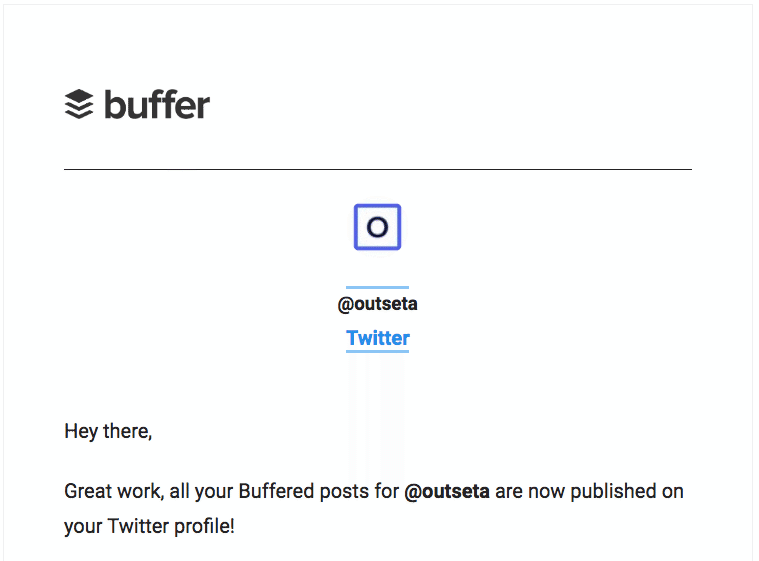
Improve customer service
As we’ve discussed, poor customer service is a leading cause of churn—companies looking to reduce churn should be on the lookout for ways to provide better quality service.
While “better” customer service can include anything from better training for your customer service representatives to expanding the hours your support team is available, you can often improve service simply by better prioritizing your most valuable customers.
For example, Mention.com, a service that monitors online mentions of your brand in popular media, knew that free trial and paid users were more valuable to their business than users on their freemium plan. They also noted that feature activation during the free trial period was strongly correlated to conversion and customer retention.
Armed with these insights, the company began prioritizing support requests from trialers and paid users over those submitted by freemium users and began sending pro-tip emails to these users highlighting valuable features of the product.
The simple act of re-prioritizing their support queue for trialers and paid users cut their response time in half and helped the company reduce churn by 22% in just one month.
Providing customers with self-service options—whether it’s product documentation in a knowledge base or video tutorials in an onboarding sequence—is another means of delivering great customer service.
According to a study by Zendesk, 67% of customers prefer self-service over talking to a company representative when they need help, and 91% of respondents said they would use a knowledge base if it were available.
By making materials like these publicly accessible, your company can combat churn while also dramatically reducing your customer support costs. As customers increasingly look to answer their own questions without speaking to a customer service rep, failure to support self-service channels may turn customers away—they may never connect with your customer service team, even if the personal support your team offers is top notch.
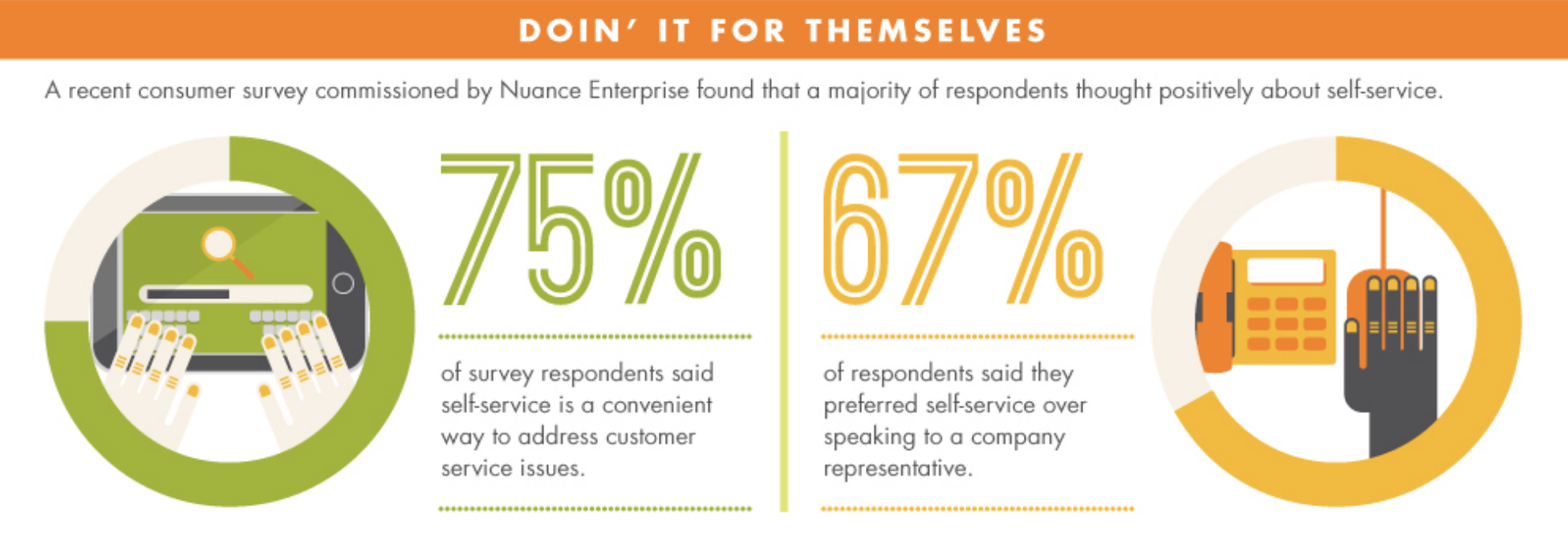
Implement a dunning process
Dunning is an automated process that works in tandem with your payment gateway to try to recover failed or delinquent payments (e.g., because of an expired credit card or a card that’s flagged for a potentially fraudulent charge).
According to Profitwell, failed or delinquent charges typically account for 20-40% of monthly recurring revenue churn in subscription businesses. Moreover, 70% or more of these issues can typically be resolved by a dunning system. Most payment gateways will offer automated dunning process tools, or you could consider using a third-party tool like Churnbuster.io.
Align your pricing with the value of your product
When the price of your product aligns with the value you’re delivering to your customers, pricing is fair for both parties and unlikely to be a major cause of churn.
For example, payment processing company Stripe charges their customers 2.9% of the transaction value for all payments processed. This model aligns both parties: when Stripe’s customers make money, Stripe makes an amount that increases in tandem with the customer’s growth.
Hire customer success managers or account managers
While triggered emails and automated dunning process management tools can help you fight churn at scale, don’t discount the importance of human intervention. A study by Genesys of over 9,000 consumers found that over 40% of respondents identified better human service as the change they’d most like to see in the companies they do business with—more than double the next highest response.
Hiring customer success or account managers often makes a lot of sense, particularly if their activities are aligned with your most profitable customers. The objective of these teams is simple: proactively engage with customers to make sure they’re achieving their goals with your product.
Strong customer relationships lead to better retention—and result in revenue growth.
Focus on your most profitable customers
One of the most common mistakes that companies make when putting together their churn fighting plan is focusing on the customers that seem most likely to churn without looking at the profitability of the account. By focusing on your most profitable customers, you have the opportunity to save a larger percentage of your profits.
“You have to look at the net profitability of the retention campaign,” says Sunil Gupta, Professor at Harvard Business School. “If I offer an incentive to customers most likely to churn, they may not leave the company, but will it be profitable for me? The traditional method is focused on reducing churn, but we contend the goal should be maximizing profits, rather than only reducing churn.”
Gupta and colleague Aurelie Lemmens’s research on this topic is detailed in their paper "A Smarter Way To Reduce Customer Defections" published in Harvard Business Review. The duo applied profitability-focused retention campaigns to a major US wireless carrier (not identified in the study). They found that the approach led to a 115% improvement in profit on average compared to traditional targeting methods. These extra profits came with no additional implementation costs for the company.
“All we did was use the same incentive you would otherwise use,” Gupta says. “There was no change in anything except who was targeted, so there was no additional cost.”
But don't try to reduce churn like this...
These are all-too-frequently used methods of reducing churn that you should avoid at all costs. While some of these tactics are popular, they are ultimately disingenuous and can lead to frustration and hostile reviews of your company when they are discovered. Being authentic and honest with your customers will help you win more business over the long term—you can do better with any of the strategies previously discussed.
- Waiting until customers cancel, then offering a discount.
- Failing to send an invoice every time a customer is charged—this tactic is often seen with subscription companies that don’t want to remind customers about their ongoing subscription charges.
- Eliminating your cancel button—this often includes making it difficult to find or requiring a phone call to cancel.
- Continuing to charge clearly inactive customers.
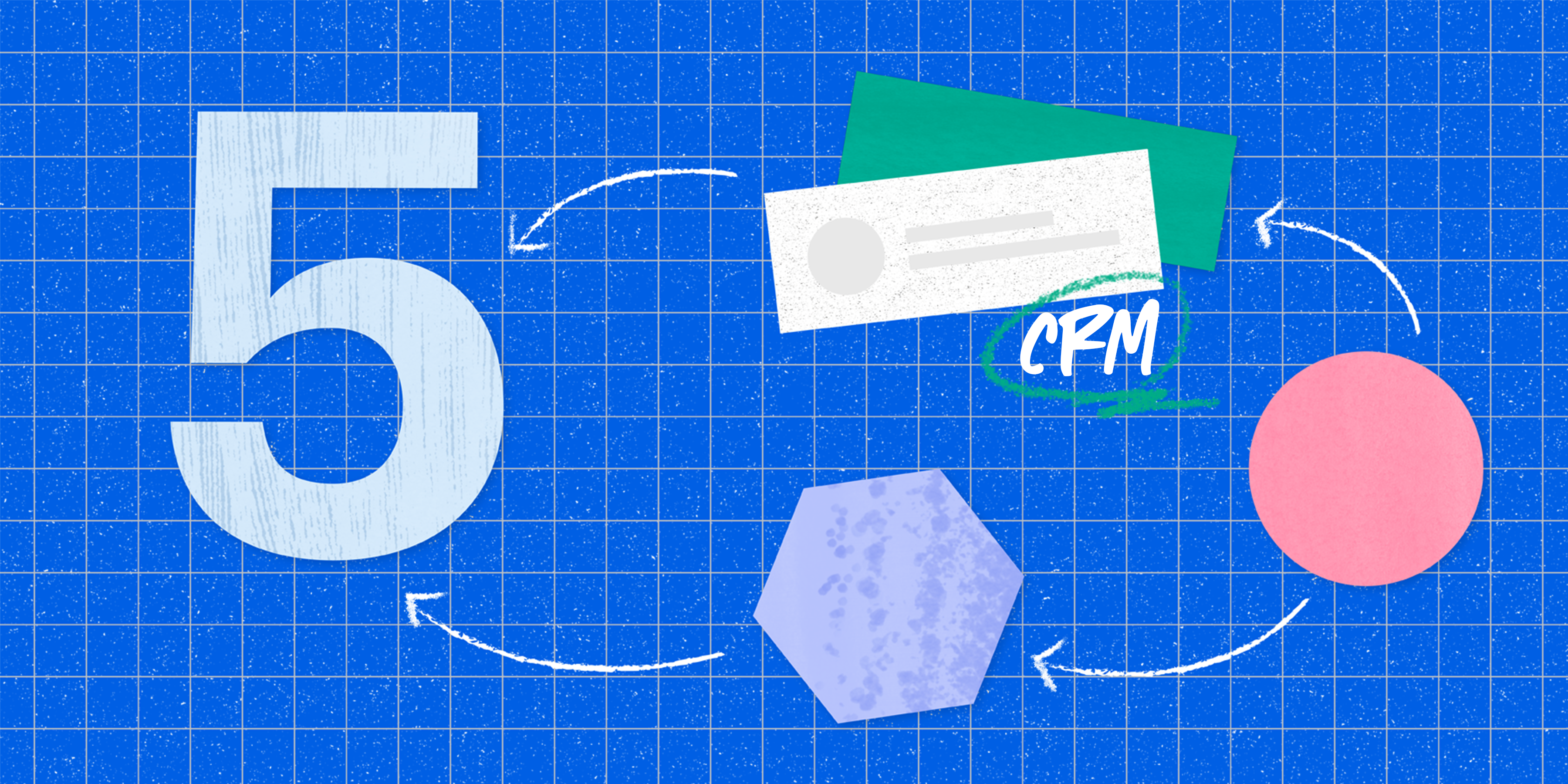
How to Use Your CRM to Beat Churn
Over 59% of marketers told CMO Council that churn directly impacts business results through lost revenue, yet 67% of surveyed respondents said they have no system for reactivating dormant or lost customers.
Reducing churn is a holistic effort that’s going to require involvement from nearly all functions within your company. “This starts at the very top of the company, and needs the CEO to articulate the importance of churn to the entire company,” says David Skok. “This should go a step further, by having the CEO provide each department a clear indication of how they contribute, and asking for this to be measured, with quantifiable targets for each quarter.”
Take these steps to begin using your CRM to fight churn.
Track buyer attributes and behaviors
It’s best to store churn-related data in your company’s CRM, where it’s most accessible to people in your organization. Your CRM records should contain information on both buyer attributes (firmographic and demographic data) and behaviors (behavioral data), which can be used for segmentation and to trigger outreach campaigns. Behavioral data should include product engagement data, so you can proactively reach out to customers who show signs of disengaging.
Create “red flag metrics”
As you implement your CRM to include churn-related data, create your own “Red Flag Metrics” as Groove did. You can automate notifications for newly “flagged” accounts and trigger automated campaigns for lower profitability customers. Flags can also be used to notify your team that manual or personal intervention might be needed for more profitable customers.
Also consider configuring your CRM with flags for metrics that aren’t necessarily leading indicators of churn—for example, flagging your most profitable accounts is useful because you can easily identify these high-value accounts that are most worthy of your attention.
Achieve negative churn: the Holy Grail
Churn reduction is almost always the result of making small incremental improvements in your churn rate over time—rarely is there a magic pill or tactic that will single-handedly change the trajectory of your business. The smartest business leaders think of churn reduction (and invest in it) like any other growth strategy, the ultimate goal of which is to reach “negative churn.”
Negative churn is realized when you start to see increased revenue from your existing customer base outpace the revenue lost to churn—this is one of the greatest turbo-boosters of growth that any business can have, as shown here:

By beginning to monitor when and why your customers churn, you can take proactive measures to retain the customers you’ve already paid so much to acquire.
Follow this formula over time, and the growth accelerating effects of negative churn may soon be within your reach!
Interested in how you can use a CRM to reduce churn and keep customers around longer? Get a demo of Copper!

Goodbye Data Entry
Hello Copper.
Try it free!
No credit card required. Start your 14-day free trial today.
